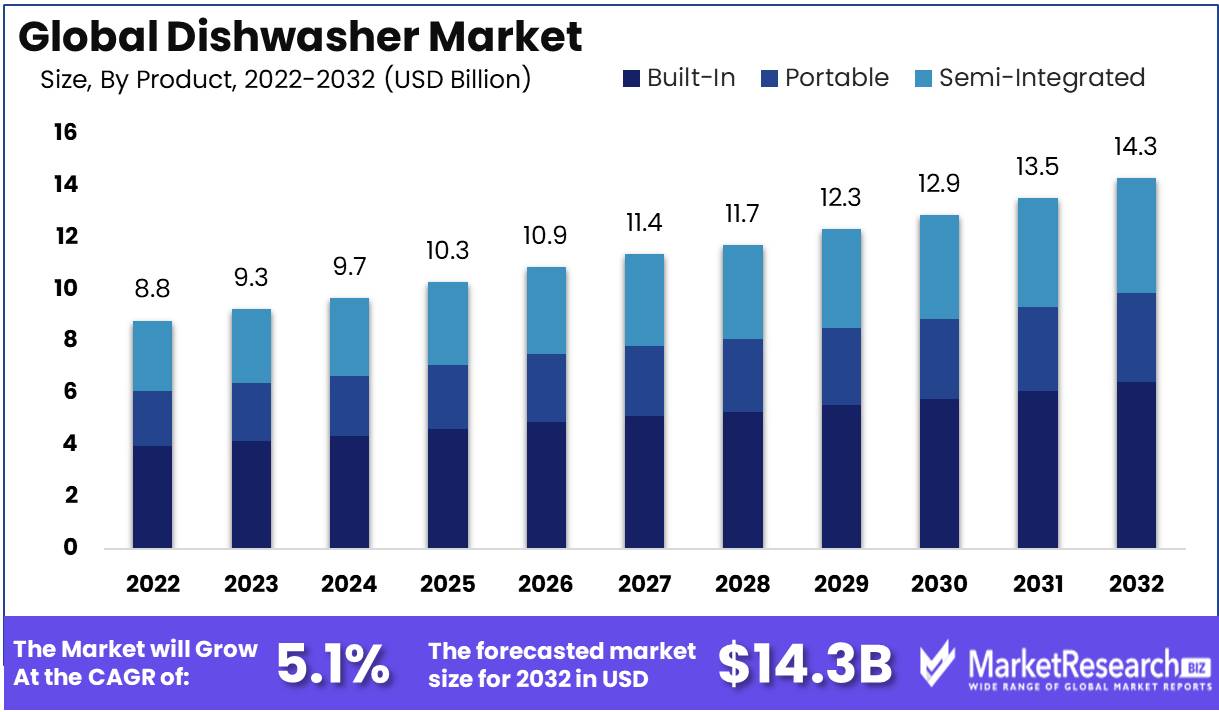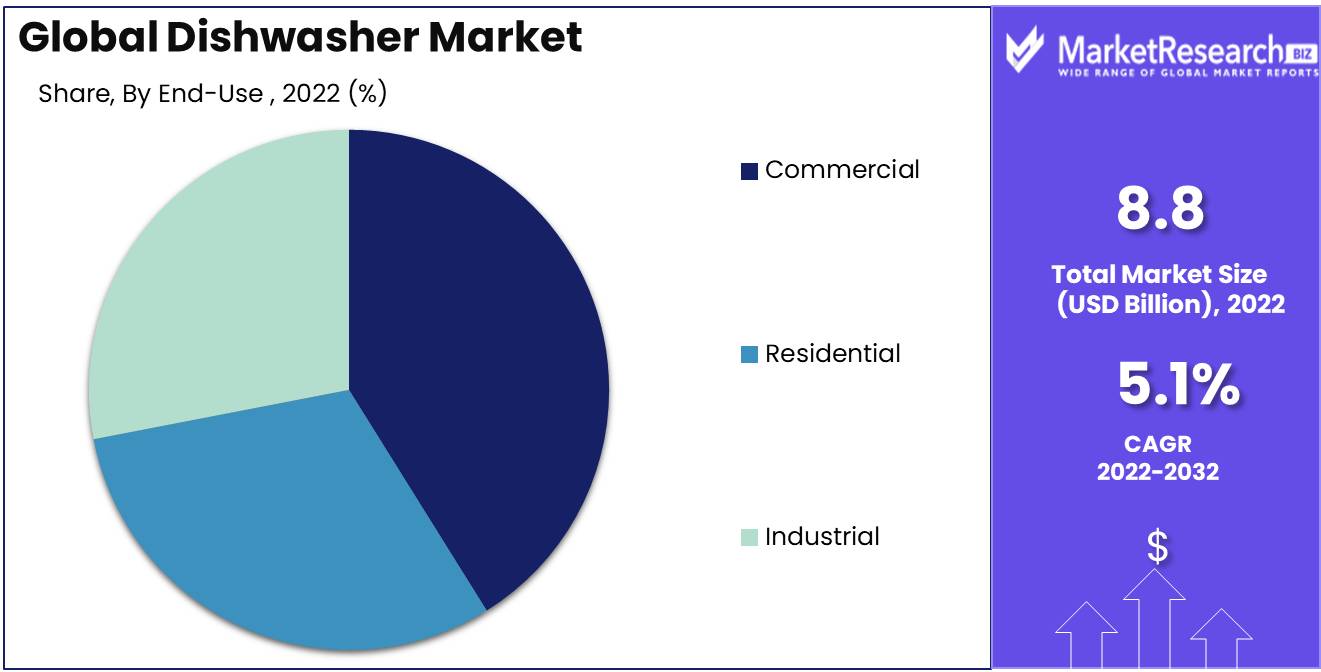
Dishwasher Market By Product(Built-In, Portable, and other), By Application (Commercial, Residential, and other), By distribution channel(Offline Sales Channels, Hypermarket/Supermarket, and other), By Region And Companies - Industry Segment Outlook, Market Assessment, Competition Scenario, Trends, And Forecast 2023-2032
-
11916
-
Jul 2023
-
154
-
-
This report was compiled by Correspondence Linkedin | Detailed Market research Methodology Our methodology involves a mix of primary research, including interviews with leading mental health experts, and secondary research from reputable medical journals and databases. View Detailed Methodology Page
-
Report Overview
Dishwasher Market size is expected to be worth around USD 14.3 Bn by 2032 from USD 8.8 Bn in 2022, growing at a CAGR of 5.1% during the forecast period from 2023 to 2032.
A dishwasher, with its complex mechanisms and remarkable capabilities, is a testimony to human ingenuity and the convenience of modern life. It is designed to clean and decontaminate a variety of kitchenware, including dishes, utensils, and cookware. The essential of a dishwasher is its ability to perform this task efficiently and effectively, saving its users valuable time and effort. By assuming the responsibility of dishwashing, it provides convenience to those who rely on it.

In recent years, the dishwasher market has been flooded with innovations, propelling this humble appliance into the realm of technological marvels. Among these developments, the emergence of intelligent dishwashers stands out in particular. These intelligent machines are outfitted with sensors and Wi-Fi connectivity, allowing for seamless communication with other intelligent domestic devices. Consequently, they can be programmed to start or halt based on predetermined conditions, which improves their efficiency and adaptability.
The cleaning process has also been revolutionized by the integration of ultrasonic technology, which eliminates even the tiniest traces of dirt or residue. In addition, the incorporation of energy-efficient components reduces energy consumption, providing economic benefits to users and promoting a more sustainable approach to dishwashing.
Driving factors
Demand Increased Due to Pandemic-Induced Home Cooking
Our cooking practices have been profoundly affected by the ongoing pandemic. As a result of individuals spending more time at home due to restrictions and limitations, home cooking has increased significantly. As a consequence, there has been a significant increase in the demand for efficient and convenient cleaning solutions, such as dishwashers. Globally, the need for a dependable and time-saving method to clear dishes after frequent cooking sessions has risen to the top of the priority list.
Effortless Workload Despite Restricted Access to Housekeepers
The pandemic has also restricted access to house assistance and maids, which has increased the demand for dishwashers as an indispensable household asset. As there are fewer housekeepers available, individuals and families have sought out dishwashers to reduce their burden and keep their kitchens clean. In these difficult times, the convenience and efficiency provided by dishwashers have become increasingly desirable.
The Rise of Modular Kitchens and Integrated Dishwashers
The increasing prominence of modular kitchen designs has significantly contributed to the expansion of the dishwasher market. These contemporary kitchen layouts are tailored to accommodate dishwashers installed invisibly. With their sleek and integrated design, built-in dishwashers have become a rising trend among householders, contributing to the market's expansion.
Restraining Factors
Frequent maintenance requirements can be an inconvenience for consumers
Dishwashers are intended to alleviate the burden of manual dishwashing and save time, but they may require regular maintenance. This may involve routine interior and exterior cleaning, mineral deposit removal, and periodic component replacement. Some consumers may be deterred from purchasing a dishwasher due to this rigorous maintenance schedule.
For some consumers, repair costs may be an entry barrier
As with all residential appliances, dishwashers are susceptible to malfunctions and breakdowns. Repair costs can be a significant barrier to entry for some consumers. Depending on the severity of the issue, repairs can be expensive and time-consuming, leading to frustration and dissatisfaction. Some consumers may refrain from purchasing a dishwasher for fear of incurring additional costs.
Product Analysis
Built-in, portable, and semi-integrated dishwashers are the three primary types. The market is dominated by the built-in segment due to its convenience and aesthetic appeal. Integrated dishwashers are installed directly into the kitchen cabinetry for a seamless and aesthetically pleasing appearance.
The rise in homeownership rates caused by economic growth in emerging economies has increased demand for built-in dishwashers. To enhance their standard of living, consumers in emerging economies are investing more in home appliances, with built-in dishwashers topping the list.
Built-in dishwashers are gaining popularity among consumers due to their convenience and ability to blend in with kitchen décor. Dishwashers are no longer regarded as a luxury, but rather a necessity in contemporary kitchens. In addition, contemporary kitchens are designed to accommodate dishwashers that are built in, making their installation and operation much simpler.
Application Analysis
The dishwasher market has experienced significant growth in recent years, with the commercial segment dominating the market. The commercial segment consists of dishwashers designed for commercial kitchens, restaurants, and other food service facilities. In contrast, the consumer segment includes domestic appliances.
In recent years, emerging economies have experienced substantial growth, with their economic development propelling the adoption of commercial segment dishwashers. Recent economic growth in developing nations like India, China, and Brazil has been unprecedented, and as a result, the number of restaurants, hotels, and other establishments of a similar nature has increased dramatically. This growth has fueled the demand for commercial dishwashers, resulting in a surge in their sales.
Today's consumers seek convenience, quality, and time-saving alternatives. As a result, dishwasher adoption in commercial kitchens and private residences is increasing. Commercial dishwashers have a number of advantages over manual washing, including enhanced hygiene standards, increased efficiency, and decreased water usage. In order to save time and money in their kitchens, consumers are opting for commercial dishwashers. In addition, commercial dishwashers are designed to withstand intensive use, making them a durable and trustworthy option for commercial kitchens.

Distribution Channel
The dishwasher industry is dominated by offline sales channels such as physical stores, retail chains, and supermarkets. As a result of the ability to physically inspect the product, compare various models, and make an informed decision, consumers prefer purchasing dishwashers offline.
Due to their economic growth, emerging economies have witnessed a surge in the number of retail chains and supermarkets. Consequently, offline distribution channels have become more accessible, making them a preferred option among consumers. In addition, physical stores continue to predominate in emerging economies with low internet penetration.
Consumers' predilection for offline shopping is primarily driven by trust concerns and the desire to physically inspect products. Despite the growing popularity of online shopping, a significant number of consumers still favor purchasing products offline. Some individuals believe that visiting an electronic store to purchase an appliance is more reliable than using websites or mobile applications.
Key Market Segments
By Product
- Built-In
- Portable
- Semi-Integrated
By Application
- Commercial
- Residential
- Industrial
By Distribution Channel
- Offline Sales Channels
- Hypermarket/Supermarket
- Specialist stores
- Mono-brand stores
- Online Stores
Growth Opportunity
Personal Disposable Income Fuels Expansion
With the rise in disposable income, the demand for domestic appliances, including dishwashers, has increased significantly. Consumers seek machines that not only simplify their lives but also save them time and effort. A dishwasher not only effectively cleans dishes but also saves time and effort, which is why it is gaining popularity in homes. In today's time-crunched society, dishwashers are not just a convenience but an essential, making them an excellent purchase for consumers.
Surge in Awareness Regarding Health & Hygiene Boosts Demand
As health and hygiene awareness increases, consumers are wary of using unclean dishes and utensils. This has led to a surge in demand for dishwashers in homes, restaurants, and hotels. Dishwashers effectively remove harmful bacteria and germs from utensils, leaving them clean and secure for use. This provides consumers with the assurance that they are taking care of their health and sanitation.
Consumers' hectic and busy lifestyles contribute to market expansion
People are busier than ever before in today's fast-paced society, leaving them with no time to manually clean dishes. A dishwasher saves time and energy, making it an essential appliance in homes, restaurants, and hotels. Not only are these machines more effective at cleaning utensils, but they also reduce the amount of time required to do so manually. Dishwashers are gaining popularity among working professionals who prefer to spend their leisure time elsewhere.
Increased Small and Medium-Sized Restaurants Drive Demand
The global expansion of the restaurant industry has led to an increase in the demand for dishwashers. Using a dishwasher to clean their utensils is more convenient and efficient for small and medium-sized restaurants, making them a necessary investment. Dishwashers are effective at cleaning large quantities of dishes rapidly, which is essential in a bustling restaurant setting. This has greatly fueled the growth of the dishwasher market.
Latest Trends
Online Stores
This segment of the dishwasher market is expanding due to a number of factors that are undergoing accelerated change. Consumers are pursuing increasingly innovative and technologically advanced dishwashers that facilitate their daily lives. Due to the convenience and simplicity of purchasing appliances online, online stores are a significant growth driver for the market.
Consumers are becoming more accustomed to online purchasing, and many prefer to purchase dishwashers online rather than in-store. Online stores offer numerous benefits, including reduced prices, a greater selection of products, and quicker delivery times. Additionally, many online stores offer free installation and disposal services, which can increase the desirability of purchasing a dishwasher online.
Fresh Product
The dishwasher market is extremely competitive, and manufacturers continually introduce new and innovative products to remain ahead of the competition. Typically, the introduction of new products generates market interest and demand for these products.
Recent technological advancements, such as intelligent dishwashers, have also increased demand for dishwashers. Dishwashers with intelligence offer a number of benefits, including remote control, customizable wash settings, and energy efficiency. As consumers become more aware of the benefits of digital dishwashers, they are more likely to purchase them.
Automatic Appliances
The increasing popularity of automatic appliances is another significant trend in the dishwasher market. Automatic dishwashers are designed to facilitate and enhance kitchen tasks. These appliances are equipped with advanced technology, including sensors that detect the level of soiling on the dishes and modify the wash cycle accordingly.
Automatic appliances also include delay start, which allows users to set a timer for the dishwasher to begin washing dishes. In addition, automatic dishwashers are equipped with energy-saving features that reduce energy consumption and, consequently, utility bills.
Regional Analysis
Due to a number of significant factors, the Asia-Pacific region has emerged as the dominant force in the dishwasher market. These factors include economic expansion, altering demographics, rising disposable incomes, and shifting consumer tastes.
In recent decades, the Asia-Pacific region has experienced significant economic expansion. Countries such as China, India, and Southeast Asian nations have experienced accelerated industrialization and urbanization, leading to a rise in the middle class. This expanding middle class has led to an increase in household incomes and an improvement in living standards, which has fueled the demand for modern appliances such as dishwashers.
The altering demographics of the region have played a crucial role. As the number of households with two incomes increases, there is a greater demand for time-saving devices that simplify household duties. Dishwashers reduce the amount of time and effort required to clean dishes, making them highly desirable appliances.
Rising disposable incomes in the Asia-Pacific region have enabled consumers to adopt a more luxurious way of life. As a consequence, consumer preferences have shifted towards automated and technologically advanced appliances. Dishwashers, with their advanced features such as energy efficiency, smart connectivity, and innovative cleaning cycles, meet the needs of this new generation of consumers.

Key Regions and Countries
North America
- US
- Canada
- Mexico
Western Europe
- Germany
- France
- The UK
- Spain
- Italy
- Portugal
- Ireland
- Austria
- Switzerland
- Benelux
- Nordic
- Rest of Western Europe
Eastern Europe
- Russia
- Poland
- The Czech Republic
- Greece
- Rest of Eastern Europe
APAC
- China
- Japan
- South Korea
- India
- Australia & New Zealand
- Indonesia
- Malaysia
- Philippines
- Singapore
- Thailand
- Vietnam
- Rest of APAC
Latin America
- Brazil
- Colombia
- Chile
- Argentina
- Costa Rica
- Rest of Latin America
Middle East & Africa
- Algeria
- Egypt
- Israel
- Kuwait
- Nigeria
- Saudi Arabia
- South Africa
- Turkey
- United Arab Emirates
- Rest of MEA
Key Players Analysis
In recent years, the dishwasher market has grown and expanded rapidly, generating a highly competitive industry. Companies such as Bosch, Whirlpool, and LG are major market players in the dishwasher industry.
Bosch, a German company, is well-known for manufacturing high-end, energy-efficient dishwashers with innovative features such as silence technology. Bosch's reputation for producing high-quality, dependable products has helped the company's brand become synonymous with quality in the dishwasher industry.
Whirlpool is an American multinational corporation that manufactures a variety of household appliances, including dishwashers. Whirlpool's dishwashers are well-known for their affordability and durability, making them a popular option for many households. Additionally, the brand is committed to eco-friendly practices, which has helped it maintain its market dominance.
South Korean electronics manufacturer LG is also a significant participant in the dishwasher market. LG dishwashers are well-known for their sleek designs and intelligent features, such as Wi-Fi connectivity, making them a popular choice among many modern consumers who wish to incorporate their appliances into smart homes.
Top Key Players in Dishwasher Market
- Robert Bosch GmbH, or Bosch
- Electrolux AB
- Maytag Corporation
- Amana Corporation
- Haier Group Corporation
- General Electric Company
- Whirlpool Corporation
- LG Electronics Inc.
- Arçelik A.Ş.
- Sears Holdings Corporation
Recent Development
- In 2022, The Whirlpool self-cleaning dishwasher will use a combination of heat and chemicals to sanitize itself. The dishwasher reaches temperatures of up to 140 degrees Fahrenheit, killing bacteria and other microorganisms. The chemicals in the dishwasher then assist in eliminating any remaining grime, food particles, and filth. This eliminates the need for users to manually sanitize the appliance, thereby saving them time and effort.
- In 2021, The Bosch built-in water purifier will remove minerals from the water, thereby preventing hard water stains and spots on dishes. The minerals in hard water, such as calcium and magnesium, can leave a film on dishes after they are rinsed. The water softener in Bosch dishwashers eliminates these minerals, resulting in spotless dinnerware.
- In 2020, Samsung dishwashers with Wi-Fi connectivity will be operable via smartphone or tablet. This allows users to start or halt a cycle, check the status of a cycle, or receive notifications when the dishwasher has completed its cycle without leaving the comfort of their couch. This can be especially beneficial for individuals who are frequently too busy to wait for the dishwasher to complete a cycle.
- In 2019, the sensor-controlled LG dishwasher detects how soiled the dishes are and adjusts the cycle length and water consumption accordingly. This allows users to save energy and water by only operating the dishwasher for the necessary amount of time. Additionally, the sensor prevents dishes from being over-cleaned, which can cause damage.
Report Scope
Report Features Description Market Value (2022) USD 8.8 Bn Forecast Revenue (2032) USD 14.3 Bn CAGR (2023-2032) 5.1% Base Year for Estimation 2022 Historic Period 2016-2022 Forecast Period 2023-2032 Report Coverage Revenue Forecast, Market Dynamics, COVID-19 Impact, Competitive Landscape, Recent Developments Segments Covered By Product(Built-In, Portable, Semi-Integrated), By Application(Commercial, Residential, Industrial), By distribution channel(Offline Sales Channels, Hypermarket/Supermarket, Specialist stores, Mono-brand stores, Online Stores) Regional Analysis North America – The US, Canada, & Mexico; Western Europe – Germany, France, The UK, Spain, Italy, Portugal, Ireland, Austria, Switzerland, Benelux, Nordic, & Rest of Western Europe; Eastern Europe – Russia, Poland, The Czech Republic, Greece, & Rest of Eastern Europe; APAC – China, Japan, South Korea, India, Australia & New Zealand, Indonesia, Malaysia, Philippines, Singapore, Thailand, Vietnam, & Rest of APAC; Latin America – Brazil, Colombia, Chile, Argentina, Costa Rica, & Rest of Latin America; Middle East & Africa – Algeria, Egypt, Israel, Kuwait, Nigeria, Saudi Arabia, South Africa, Turkey, United Arab Emirates, & Rest of MEA Competitive Landscape Robert Bosch GmbH, or Bosch, Electrolux AB, Maytag Corporation, Amana Corporation, Haier Group Corporation, General Electric Company, Whirlpool Corporation, LG Electronics Inc., Arçelik A.Ş., Sears Holdings Corporation Customization Scope Customization for segments, region/country-level will be provided. Moreover, additional customization can be done based on the requirements. Purchase Options We have three licenses to opt for: Single User License, Multi-User License (Up to 5 Users), Corporate Use License (Unlimited User and Printable PDF) -
-
- Robert Bosch GmbH, or Bosch
- Electrolux AB
- Maytag Corporation
- Amana Corporation
- Haier Group Corporation
- General Electric Company
- Whirlpool Corporation
- LG Electronics Inc.
- Arçelik A.Ş.
- Sears Holdings Corporation




